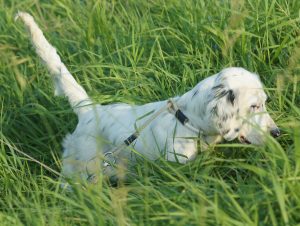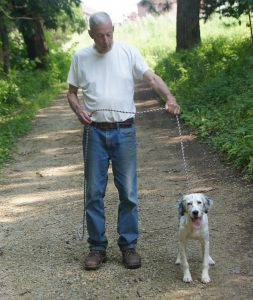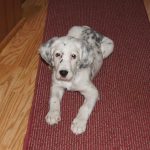Training the Soft Dog
POINTING DOG POINTERS June 2018
By Bob and Jody Iler
In our columns we often talk about “reading” our pointing dog pup. For the novice owner this might seem a bit difficult to do, but there’s nothing magical or mysterious about it. And the more dogs that are in your life over the years, the easier it becomes. As trainers, we’ve had the privilege of handling many pointing dogs. Reading each pup – noting how they perceive the world, handle new people and adventures, and react to birds – provides the key to what method we will use to develop that pup.
This month we’ll focus on the soft dog – the one that seems a bit reserved or shy, and maybe even a little scared of new and different situations. If you think about it, pups are just like kids, with their own innate personality. If your canine “kid” seems a little timid, this doesn’t mean she won’t be a superb bird dog – only that the way you’ll train her will be different than if she was bold, adventurous, and thick-skinned. The soft pup – once she feels confident in her surroundings and with you and your training methods – often exhibits happy, tail-wagging enthusiasm as she develops.
Birds, yard work (obedience), and gun development form the bedrock of the pointing dog training program. Of course, introduction to birds and bird work is key no matter what the pup’s temperament, but particularly so for the soft dog. Emphasis on obedience and gun work should be put on hold until the soft pup has been gently introduced to birds and allowed to hunt, point, and chase birds for a good period of time. At this point, we aren’t worried about her “manners” or even whether she jumps in on a bird.
The goal is to get the soft pup as birdy as all get-out! We want this pup to be quivering with excitement at the prospect of heading to the field and finding birds. We want this pup to take off like a rocket in the field, covering a lot of area as she hunts. We want her to find and point birds and chase with happy enthusiasm. Then, and only then, will we start putting some control into her – in the form of introduction to yard work.
We’ve had soft pups at our kennel that already have a special fire burning inside, just waiting to come out. It’s something that can’t be put into them – it’s part of their genetics. With these pups, although they might seem shy or timid around the house, kennel, or with other people, they transform in the field. And – as long as you use gentle, step by step methods of development, this type of soft pup will generally turn on in the field like a switch.
We’ve also seen other soft pups who’ve been run through an obedience program prior to coming to our kennel. They may even have been introduced to the e-collar for control work, or gotten used to an electronic fence in the yard. If these pups aren’t already ingrained with the eye of the tiger – it can be a challenge to get them interested in birds initially. They’ve learned restraint and can be inhibited in the field, reluctant to get out there and look for birds. Remember that you can always put control and yard work in your soft pup, but first – focus on bringing out the bird dog part of her!
With soft dogs, it’s especially important not to have a timetable. Gentler training aids such as a nylon slip training collar, six-foot lead, and checkcord are often all you need to instill field control and the yard work commands of heel, whoa and here (come). Avoid the use of noisy bird releasers, e-collars (even the toner, vibrator or locator options), and the initial use of large rooster pheasants. Start bird work with small birds like quail and closely watch pup’s reactions as he learns to recognize scent, hunt, and chase birds. Fan his enthusiasm like a flame and keep things fun and positive.
Dog training is always ongoing! Successfully developing your soft pointing dog for his first season is just the beginning. It’s important to be watchful of situations that can undo your patient training and his development.
Let’s look at an example. Web was a two-year-old pointer that came into our kennel from the South, bred from a line of pointers known for their softness. Web was gun-shy. He’d had a great first season with his owner, but during the second season, multiple hunters shooting at a covey of quail found Web hightailing it back to his owner’s pickup and hiding underneath it.
When we got him, Web was a loving and very insecure guy who piddled in his kennel when we talked to him. Things did not look good. We made friends with him with lots of sweet talk, treats, and walks. Slowly we reintroduced him to the field. Initially he was wary and unsure, visibly uncomfortable.
But – Web had the fire inside! Just as genetics had dictated that he was soft, they had also given him an unquenchable love for birds. And this saved him. We encouraged him to hunt, find and point birds, and chase them after the flush. Without this innate love of birds, we would not have been able to help Web.
We had no timetable for Web, either. We let him have fun and gain back his confidence for well over a month before we began introducing even small noise, such as clapping blocks together. Slowly, we worked with Web through our gradual progression of gun development. Eventually Web returned to his owner with instructions to hunt no more than two people over him at a time, with only one shooting. It took time and patience, but even this extremely soft Pointer was able to come back, primarily because he loved the birds.
Putting too much pressure on soft dogs in other ways can also set them back. Trying to steady a soft young dog to wing, or wing and shot, before he is ready can undo a promising young student. Shooting too many birds over a soft dog in one session can cause him to quit retrieving altogether. And force breaking a soft dog to retrieve, especially too soon, can often be a disaster, causing him to turn off of birds altogether.
Soft dogs are not breed specific. A pointing dog of any breed can be on the soft side. But with understanding, patience and a gentle development program, the soft dog can turn out to be the best pointing dog you’ll ever have!
Pointing Dog Pointers features monthly training tips by Bob and Jody Iler, who own Green Valley Kennels in Dubuque, Iowa. Bob and Jody have trained pointing dogs for over 35 years and have written many articles for The Pointing Dog Journal.







